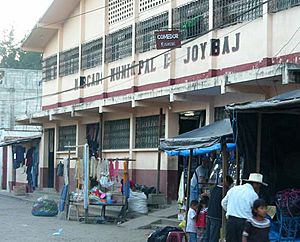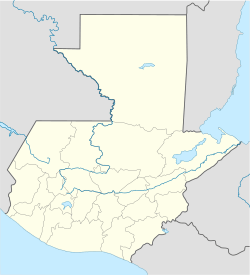Joyabaj facts for kids
Quick facts for kids
Joyabaj
Sho' la baj
|
|
|---|---|
|
Municipality
|
|

Municipal Market of Joyabaj
|
|
| Country | |
| Department | |
| Municipality | Joyabaj |
| Government | |
| • Type | Municipal |
| Area | |
| • Municipality | 338 km2 (131 sq mi) |
| Population
(Census 2018)
|
|
| • Municipality | 82,369 |
| • Density | 243.7/km2 (631.2/sq mi) |
| • Urban | 15,451 |
| • Ethnicities | K'iche' Ladino |
| • Religions | Roman Catholicism Evangelicalism Maya The Church of Jesus Christ of Latter-day Saints |
| Climate | Aw |
Joyabaj (pronounced like "ho-yah-BAH") is a town in Guatemala. It is also a municipality, which is like a local government area. Joyabaj is part of the El Quiché region in Guatemala.
This town is located about 50 kilometers (about 31 miles) from Santa Cruz del Quiché. You can find it nestled in the Sierra de Chuacús mountains.
A Look at Joyabaj
Joyabaj has a rich history and a vibrant culture. The people who live here are often called Xoyes or Joyabatecos.
Joyabaj Through History
Long ago, during the time of Spanish rule, Joyabaj was an important stop. It was on a main route that connected to Mexico.
However, the town has faced tough times. On February 4, 1976, a big earthquake hit. It almost completely destroyed Joyabaj. Many beautiful old buildings were lost, and many people sadly died.
Later, Joyabaj was also affected by a long civil war in Guatemala. This war lasted for about 30 years. During this time, many ladinos (people with mixed Spanish and Indigenous heritage) moved away. They often went to Guatemala City to find safety.
Culture and Traditions
One of the most exciting times in Joyabaj is the town's annual fiesta. This celebration takes place from August 8th to August 15th. There are many fun activities happening every day.
A very special and amazing part of the fiesta is called El Palo Volador. This means "The Flying Pole". It is a traditional dance where performers, dressed as "flying angels" (ángeles), spin down from a very tall wooden pole.
This dance is a very old ritual, even older than the Spanish arrival. It shows the angels going down to the underworld to fight against dark forces. It's a powerful and beautiful tradition that has been kept alive for many centuries.
See also
 In Spanish: Joyabaj para niños
In Spanish: Joyabaj para niños


